2000 FORD SUPER DUTY fuel pressure
[x] Cancel search: fuel pressurePage 202 of 256
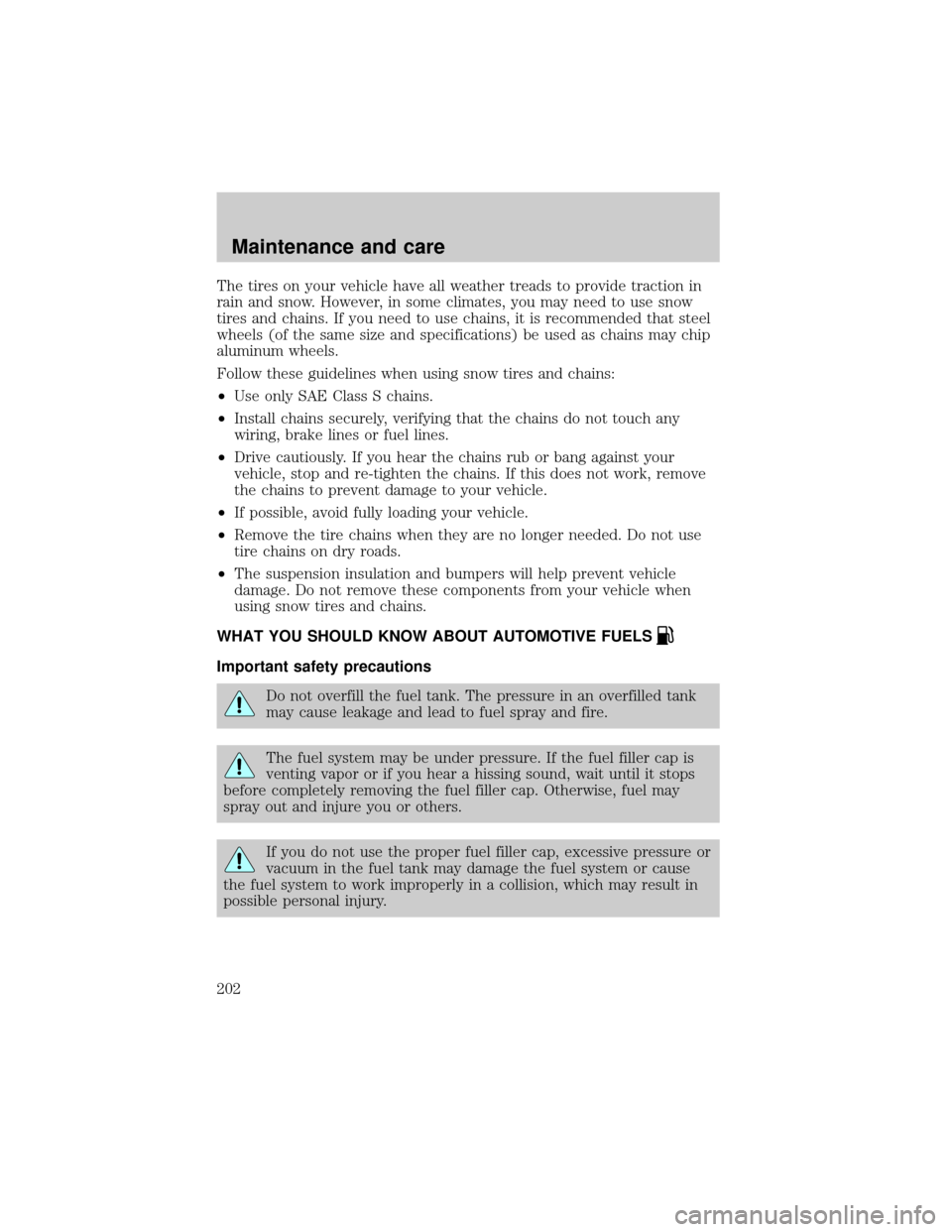
The tires on your vehicle have all weather treads to provide traction in
rain and snow. However, in some climates, you may need to use snow
tires and chains. If you need to use chains, it is recommended that steel
wheels (of the same size and specifications) be used as chains may chip
aluminum wheels.
Follow these guidelines when using snow tires and chains:
²Use only SAE Class S chains.
²Install chains securely, verifying that the chains do not touch any
wiring, brake lines or fuel lines.
²Drive cautiously. If you hear the chains rub or bang against your
vehicle, stop and re-tighten the chains. If this does not work, remove
the chains to prevent damage to your vehicle.
²If possible, avoid fully loading your vehicle.
²Remove the tire chains when they are no longer needed. Do not use
tire chains on dry roads.
²The suspension insulation and bumpers will help prevent vehicle
damage. Do not remove these components from your vehicle when
using snow tires and chains.
WHAT YOU SHOULD KNOW ABOUT AUTOMOTIVE FUELS
Important safety precautions
Do not overfill the fuel tank. The pressure in an overfilled tank
may cause leakage and lead to fuel spray and fire.
The fuel system may be under pressure. If the fuel filler cap is
venting vapor or if you hear a hissing sound, wait until it stops
before completely removing the fuel filler cap. Otherwise, fuel may
spray out and injure you or others.
If you do not use the proper fuel filler cap, excessive pressure or
vacuum in the fuel tank may damage the fuel system or cause
the fuel system to work improperly in a collision, which may result in
possible personal injury.
Maintenance and care
202
Page 206 of 256
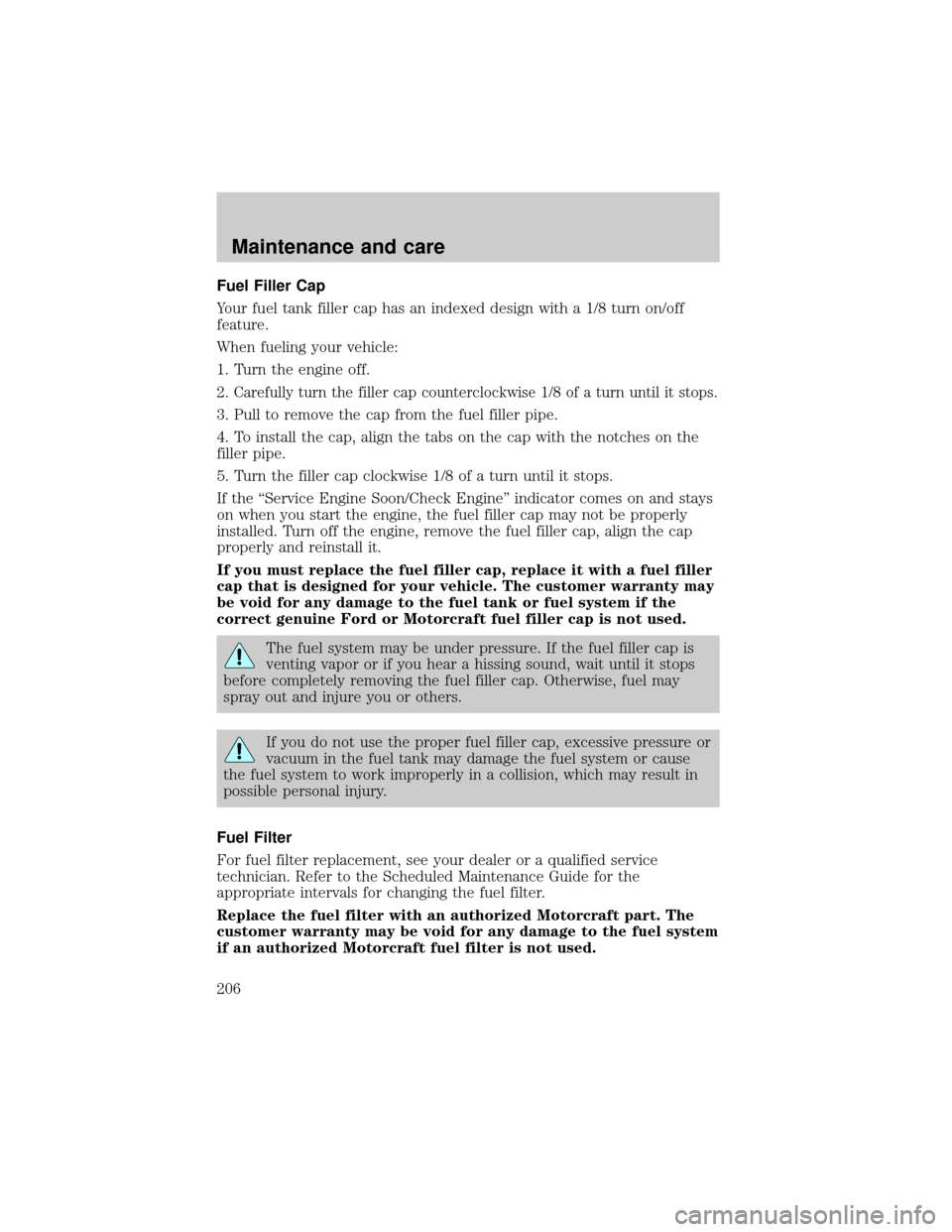
Fuel Filler Cap
Your fuel tank filler cap has an indexed design with a 1/8 turn on/off
feature.
When fueling your vehicle:
1. Turn the engine off.
2.
Carefully turn the filler cap counterclockwise 1/8 of a turn until it stops.
3. Pull to remove the cap from the fuel filler pipe.
4. To install the cap, align the tabs on the cap with the notches on the
filler pipe.
5. Turn the filler cap clockwise 1/8 of a turn until it stops.
If the ªService Engine Soon/Check Engineº indicator comes on and stays
on when you start the engine, the fuel filler cap may not be properly
installed. Turn off the engine, remove the fuel filler cap, align the cap
properly and reinstall it.
If you must replace the fuel filler cap, replace it with a fuel filler
cap that is designed for your vehicle. The customer warranty may
be void for any damage to the fuel tank or fuel system if the
correct genuine Ford or Motorcraft fuel filler cap is not used.
The fuel system may be under pressure. If the fuel filler cap is
venting vapor or if you hear a hissing sound, wait until it stops
before completely removing the fuel filler cap. Otherwise, fuel may
spray out and injure you or others.
If you do not use the proper fuel filler cap, excessive pressure or
vacuum in the fuel tank may damage the fuel system or cause
the fuel system to work improperly in a collision, which may result in
possible personal injury.
Fuel Filter
For fuel filter replacement, see your dealer or a qualified service
technician. Refer to the Scheduled Maintenance Guide for the
appropriate intervals for changing the fuel filter.
Replace the fuel filter with an authorized Motorcraft part. The
customer warranty may be void for any damage to the fuel system
if an authorized Motorcraft fuel filter is not used.
Maintenance and care
206
Page 209 of 256
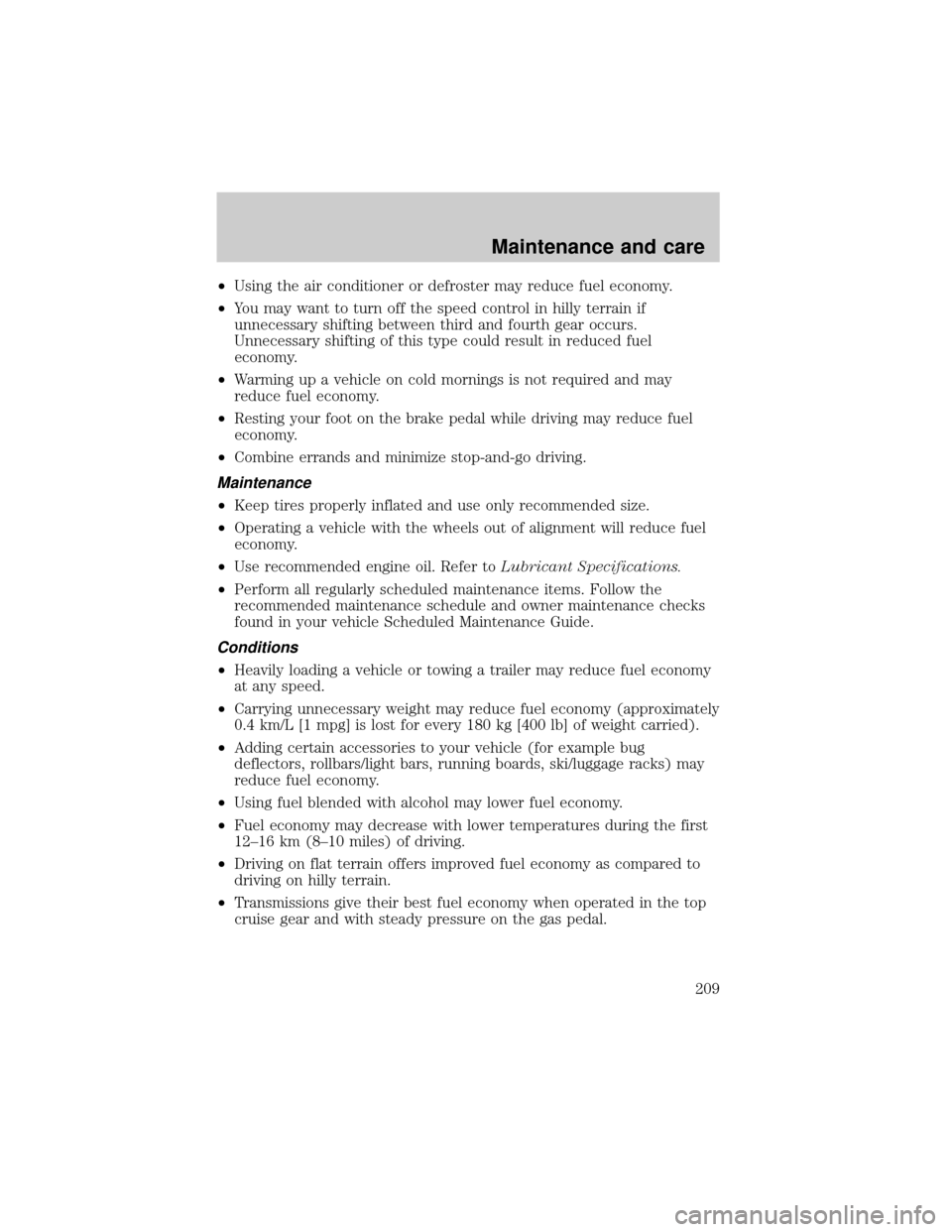
²Using the air conditioner or defroster may reduce fuel economy.
²You may want to turn off the speed control in hilly terrain if
unnecessary shifting between third and fourth gear occurs.
Unnecessary shifting of this type could result in reduced fuel
economy.
²Warming up a vehicle on cold mornings is not required and may
reduce fuel economy.
²Resting your foot on the brake pedal while driving may reduce fuel
economy.
²Combine errands and minimize stop-and-go driving.
Maintenance
²Keep tires properly inflated and use only recommended size.
²Operating a vehicle with the wheels out of alignment will reduce fuel
economy.
²Use recommended engine oil. Refer toLubricant Specifications.
²Perform all regularly scheduled maintenance items. Follow the
recommended maintenance schedule and owner maintenance checks
found in your vehicle Scheduled Maintenance Guide.
Conditions
²Heavily loading a vehicle or towing a trailer may reduce fuel economy
at any speed.
²Carrying unnecessary weight may reduce fuel economy (approximately
0.4 km/L [1 mpg] is lost for every 180 kg [400 lb] of weight carried).
²Adding certain accessories to your vehicle (for example bug
deflectors, rollbars/light bars, running boards, ski/luggage racks) may
reduce fuel economy.
²Using fuel blended with alcohol may lower fuel economy.
²Fuel economy may decrease with lower temperatures during the first
12±16 km (8±10 miles) of driving.
²Driving on flat terrain offers improved fuel economy as compared to
driving on hilly terrain.
²Transmissions give their best fuel economy when operated in the top
cruise gear and with steady pressure on the gas pedal.
Maintenance and care
209
Page 219 of 256
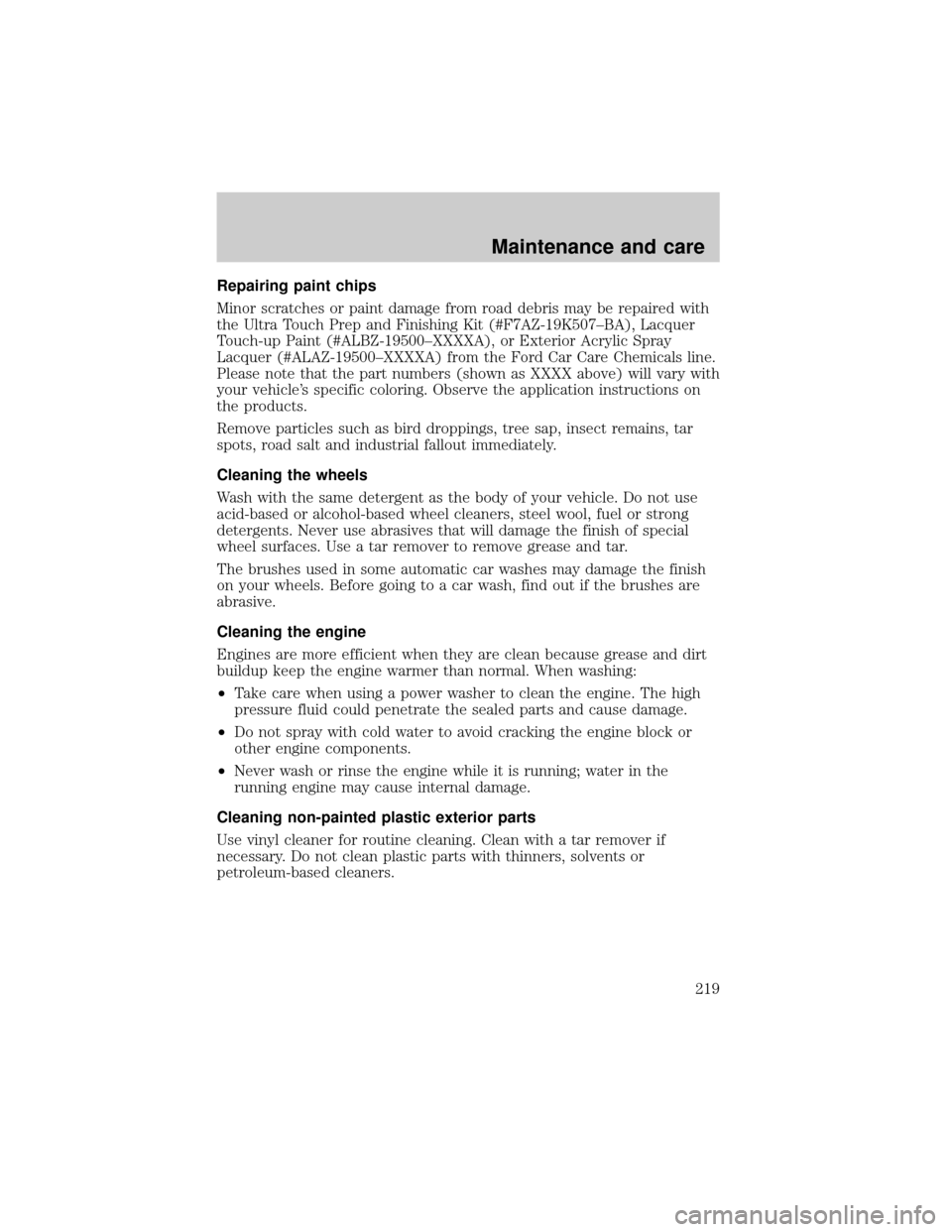
Repairing paint chips
Minor scratches or paint damage from road debris may be repaired with
the Ultra Touch Prep and Finishing Kit (#F7AZ-19K507±BA), Lacquer
Touch-up Paint (#ALBZ-19500±XXXXA), or Exterior Acrylic Spray
Lacquer (#ALAZ-19500±XXXXA) from the Ford Car Care Chemicals line.
Please note that the part numbers (shown as XXXX above) will vary with
your vehicle's specific coloring. Observe the application instructions on
the products.
Remove particles such as bird droppings, tree sap, insect remains, tar
spots, road salt and industrial fallout immediately.
Cleaning the wheels
Wash with the same detergent as the body of your vehicle. Do not use
acid-based or alcohol-based wheel cleaners, steel wool, fuel or strong
detergents. Never use abrasives that will damage the finish of special
wheel surfaces. Use a tar remover to remove grease and tar.
The brushes used in some automatic car washes may damage the finish
on your wheels. Before going to a car wash, find out if the brushes are
abrasive.
Cleaning the engine
Engines are more efficient when they are clean because grease and dirt
buildup keep the engine warmer than normal. When washing:
²Take care when using a power washer to clean the engine. The high
pressure fluid could penetrate the sealed parts and cause damage.
²Do not spray with cold water to avoid cracking the engine block or
other engine components.
²Never wash or rinse the engine while it is running; water in the
running engine may cause internal damage.
Cleaning non-painted plastic exterior parts
Use vinyl cleaner for routine cleaning. Clean with a tar remover if
necessary. Do not clean plastic parts with thinners, solvents or
petroleum-based cleaners.
Maintenance and care
219
Page 249 of 256

capacity ...................................222
choosing the right fuel ...........204
comparisons with EPA fuel
economy estimates .................210
detergent in fuel .....................205
filling your
vehicle with fuel .......202,206,207
filter, specifications .........206,222
fuel pump shut-off switch .....146
gauge .........................................17
improving fuel economy ........207
low fuel warning light ..............10
octane rating .............204,227,228
quality ......................................205
running out of fuel .................205
safety information relating to
automotive fuels .....................202
Fuses ...................................147,148
Gas cap (see Fuel cap) ............206
Gas mileage
(see Fuel economy) .................207
Gauges .........................................16
battery voltage gauge ...............19
engine coolant
temperature gauge ...................17
engine oil pressure gauge ........19
fuel gauge ..................................17
odometer ...................................18
speedometer .............................17
tachometer ................................19
trip odometer ............................18
GAWR
(Gross Axle Weight Rating) .....132
calculating ...............................134
definition .................................132
driving with a heavy load ......132
location ....................................132
GVWR (Gross
Vehicle Weight Rating) .............132
calculating ........................132,134
definition .................................132
driving with a heavy load ......132location ....................................132
Hazard flashers .........................146
Headlamps ...................................25
aiming ......................................217
daytime running lights .............25
flash to pass ..............................26
high beam ............................14,25
replacing bulbs ................212,213
turning on and off ....................25
warning chime ..........................16
Heating ........................................27
heater only system ...................27
heating and
air conditioning system ............29
Hood ..........................................174
Ignition ................................227,228
positions of the ignition ...........55
removing the key ....................122
Infant seats (see Safety seats) ..98
Inspection/
maintenance (I/M) testing .......211
Instrument panel
cleaning ...................................220
cluster .................................10,220
lighting up
panel and interior .....................26
location of components ............10
Jump-starting your vehicle ......166
Keys
key in ignition chime ...............16
positions of the ignition ...........55
removing from the ignition ....122
Lamps
autolamp system .....................212
bulb replacement
specifications chart ................216
cargo lamps ...............................26
daytime running light ...............25
headlamps .................................25
headlamps, flash to pass ..........26
instrument panel, dimming .....26
Index
249
Page 250 of 256

replacing
bulbs ............212,213,214,215,216
Lane change indicator
(see Turn signal) ........................56
Lights, warning and indicator ....10
air bag ........................................13
anti-lock brakes (ABS) .....14,110
brake ..........................................13
charging system ........................14
check coolant ............................15
cruise indicator .........................15
door ajar ....................................15
engine oil pressure ...................15
high beam .................................14
low fuel ......................................10
safety belt .................................13
service engine soon .............10,11
turn signal indicator .................14
Load limits .................................132
GAWR ......................................132
GVWR ......................................132
trailer towing ..........................132
Loading instructions .................134
Locks
childproof ..................................64
Lubricant specifications ....225,227
Lumbar support, seats ...............75
Manual transmission .................117
fluid capacities ........................222
lubricant specifications ..........227
reverse .....................................121
Message center ...........................20
english/metric button ...............20
menu button .............................20
Mirrors .........................................66
fold away ...................................65
heated ........................................65
side view mirrors (power) .......64
Motorcraft parts .................206,222
Octane rating ............................204
Odometer .....................................18
Oil (see Engine oil) ..................176Overdrive .....................................61
Panic alarm feature, remote
entry system ................................68
Parking brake ............................111
Parts (see Motorcraft parts) ....222
Power distribution box
(see Fuses) ...............................152
Power door locks ........................63
Power steering ..........................112
fluid, checking and adding ....188
fluid, refill capacity ................222
fluid, specifications ..........225,227
Preparing to
drive your vehicle .....................113
Radio ............................................32
Relays ........................................147
Remote entry system ............67,68
illuminated entry ......................69
locking/unlocking doors ...........67
panic alarm ...............................68
replacement/additional
transmitters ..........................70,71
replacing the batteries .............68
Safety belts (see Safety
restraints) ...........16,75,77,78,79,81
Safety defects, reporting ..........246
Safety restraints ......75,77,78,79,81
belt minder ...............................84
cleaning the safety belts ...87,221
extension assembly ..................83
for adults .........................77,78,79
for children ..........................96,97
lap belt ......................................82
warning light
and chime ...................13,16,83,84
Safety seats for children ............98
Seat belts
(see Safety restraints) ...............75
Seats ............................................72
child safety seats ......................98
cleaning ...................................221
Servicing your vehicle ..............172
Index
250
Page 255 of 256
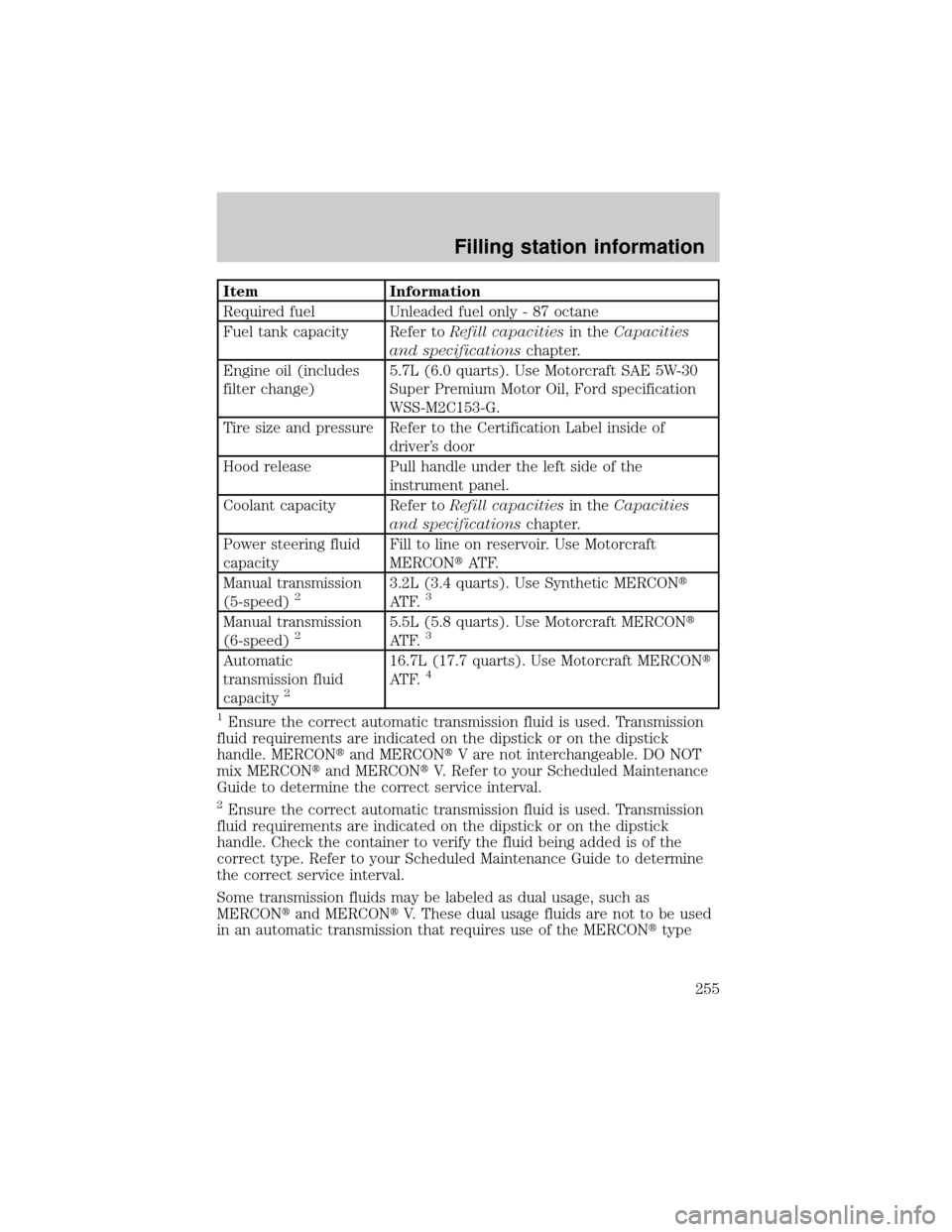
Item Information
Required fuel Unleaded fuel only - 87 octane
Fuel tank capacity Refer toRefill capacitiesin theCapacities
and specificationschapter.
Engine oil (includes
filter change)5.7L (6.0 quarts). Use Motorcraft SAE 5W-30
Super Premium Motor Oil, Ford specification
WSS-M2C153-G.
Tire size and pressure Refer to the Certification Label inside of
driver's door
Hood release Pull handle under the left side of the
instrument panel.
Coolant capacity Refer toRefill capacitiesin theCapacities
and specificationschapter.
Power steering fluid
capacityFill to line on reservoir. Use Motorcraft
MERCONtAT F.
Manual transmission
(5-speed)
23.2L (3.4 quarts). Use Synthetic MERCONt
AT F.3
Manual transmission
(6-speed)25.5L (5.8 quarts). Use Motorcraft MERCONt
AT F.3
Automatic
transmission fluid
capacity
2
16.7L (17.7 quarts). Use Motorcraft MERCONt
AT F.4
1
Ensure the correct automatic transmission fluid is used. Transmission
fluid requirements are indicated on the dipstick or on the dipstick
handle. MERCONtand MERCONtV are not interchangeable. DO NOT
mix MERCONtand MERCONtV. Refer to your Scheduled Maintenance
Guide to determine the correct service interval.
2Ensure the correct automatic transmission fluid is used. Transmission
fluid requirements are indicated on the dipstick or on the dipstick
handle. Check the container to verify the fluid being added is of the
correct type. Refer to your Scheduled Maintenance Guide to determine
the correct service interval.
Some transmission fluids may be labeled as dual usage, such as
MERCONtand MERCONtV. These dual usage fluids are not to be used
in an automatic transmission that requires use of the MERCONttype
Filling station information
255